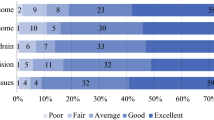Abstract
Background
Enhanced recovery after surgery (ERAS) protocols have been shown to improve surgical, anesthetic, and economic outcomes in intermediate-to-high-risk surgeries. Its influence on length of stay and cost of low-risk surgeries has yet to be robustly studied. As value-based patient care comes to the forefront of anesthesiology research, the focus shifts to strategies that maintain quality while effectively containing cost.
Methods
In July 2016, we implemented an ERAS for mastectomy protocol consisting of limiting fasting state, preoperative multimodal analgesia, and pectoralis I and II blocks. After 1 year, patient records were retrospectively reviewed for length of stay, opioid consumption, pain scores, and hospital charges.
Results
Implementation of an ERAS protocol for mastectomies led to a decrease in opioid consumption, and statistically significant decrease in length of stay (1.19 vs. 1.44, p = 0.01). No significant change in hospital charges was observed ($25,787 vs. $25,863, p = 0.97); however, the variance of charges was significantly decreased (6.8 × 107 vs. 1.5 × 108, p = 0.002). The decrease in length of stay translated to an extra 100 hospital bed days which can provide up to an additional $2,100,000 in gross patient service revenue from additional mastectomy volume.
Conclusion
ERAS protocols for mastectomies may prove beneficial by allowing growing hospitals to increase bed capacity and consequently surgical volume. Despite no change in hospital charges, we predict a potential increase in gross patient service revenue of $2.1 million due to saved hospital bed days.





Similar content being viewed by others
References
Lau CS, Chamberlain RS (2017) Enhanced recovery after surgery programs improve patient outcomes and recovery: a meta-analysis. World J Surg 41:899–913. https://doi.org/10.1007/s00268-016-3807-4
Ljungqvist O, Scott M, Fearon KC (2017) Enhanced recovery after surgery: a review. JAMA Surg 152:292–298
Stowers MDJ, Lemanu DP, Hill AG (2015) Health economics in enhanced recovery after surgery programs. Can J Anaesth 62:219–230
Stone AB, Grant MC, Pio Roda C et al (2016) Implementation costs of an enhanced recovery after surgery program in the United States: a financial model and sensitivity analysis based on a quaternary academic medical center. J Am Coll Surg 222:219–225
Duriaud HM, Kroman N, Kehlet H (2018) Feasibility and safety of outpatient breast cancer surgery. Dan Med J 65:pii:A5458
Bowen ME, Mone CM, Buys SS, Sheng X, Nelson EW (2017) Surgical outcome for mastectomy patients receiving neoadjuvant chemotherapy. Ann Surg 265:448–456
Astanehe A, Temple-Oberle C, Nielsen M et al (2018) An enhanced recovery after surgery pathway for microvascular breast reconstruction is safe and effective. Plast Reconstr Surg Glob Open 6:e1634
Batdorf NJ, Lemaine V, Lovely JK et al (2015) Enhanced recovery after surgery in microvascular breast reconstruction. J Plast Reconstr Aesthet Surg 68:395–402
Dirks J, Fredensborg BB, Christensen D et al (2002) A randomized study of the effects of gabapentin versus placebo on postoperative pain and morphine consumption after mastectomy. Anesthesiology 97:560–564
Bhashandy GM, Abbas DN (2015) Pectoral nerves I and II blocks in multimodal analgesia for breast cancer surgery. Reg Anesth Pain Med 40:68–74
Arsalani-Zadeh R, Elfadl D, Yassin N, MacFie J (2011) Evidence-based review of enhancing postoperative recovery after breast surgery. Br J Surg 98:181–186
Anderson RSJ, Abram S, Schlicht C (2001) Accuracy in Equianalgesic Dosing. J Pain Symptom Manag 21:397–406
Sun SX, Leung AN, Dillon PW, Hollenbeak CS (2015) Length of stay and readmission in mastectomy patients. Breast J 21:526–532
Coopey SB, Spechy MC, Warren L, Smith BL, Winograd JM, Fleischmann K (2013) Use of preoperative paravertebral block decreases length of stay in patients undergoing mastectomy plus immediate reconstruction. Ann Surg Oncol 20:1282–1286
Chipollini J, Tang DH, Hussein K et al (2017) Does implementing an enhanced recovery after surgery protocol increase hospital charges? Comparison from a radical cystectomy program at a specialty cancer center. Urology 105:108–112
Wakeam E, Molina G, Shah N et al (2017) Variation in the cost of 5 common operations in the United States. Surgery 162:592–604
Nilsson H, Angera U, Bock D et al (2016) Is preoperative physical activity related to post-surgery recovery? A cohort study of patients with breast cancer. BMJ Open 6:e007997
Fassoulaki A, Triga A, Melemeni A, Sarantopoulos C (2005) Multimodal analgesia with gabapentin and local anesthetics prevents acute and chronic pain after breast surgery. Anesth Analg 101:1427–1432
Author information
Authors and Affiliations
Corresponding author
Ethics declarations
Conflict of interest
The authors declare that they have no conflict of interests.
Rights and permissions
About this article
Cite this article
Ackerman, R.S., Hirschi, M., Alford, B. et al. Enhanced REVENUE After Surgery? A Cost-Standardized Enhanced Recovery Pathway for Mastectomy Decreases Length of Stay. World J Surg 43, 839–845 (2019). https://doi.org/10.1007/s00268-018-4850-0
Published:
Issue Date:
DOI: https://doi.org/10.1007/s00268-018-4850-0




